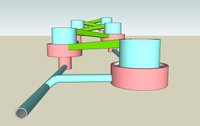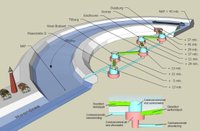Stevelduct Provides Energy Free Transport
The Stevelduct as originally envisioned provided for emissions-free transportation of standard size cargo containers by re-cycling a combination of old technologies that had fallen into disuse. A further development, again based on ancient Roman construction techniques, has now led to a configuration of the Stevelduct that operates on an energy-free basis. Too good to be true? Read on.
As has been described elsewhere, the Stevelduct works on a similar principle as an aquaduct. Both feature a particular flow of water occasioned by a particular drop in elevation of the watercourse. The flow of water required to move the vessels with containers through a Stevelduct has been calculated to be 60,000 cubic meters per hour or 1.000 cubic meters of water every minute. That is a considerable amount of water to contain and direct. Absent other possibilities, that volume of water would need to be obtained and pumped into the upstream end of the Stevelduct.
In the original concept version of the Stevelduct, the energy required for this pumping was considered obtainable by the use of energy from green sources, at first blush a reasonably acceptable manner to get to an emissions-free form of transport. However. Nature provides a form of energy that can be readily adapted to serve this new form of transport technology. There is a form of potential energy stored up in river water.
It is an elementary rule of physics that the level of liquid in connected containers will always be at the same level. To apply the rule on a large scale, one might start with the level of water in the Rhine River at the city of Bonn. Water may be diverted by way of an underground pipeline to a distant container. The level of water in the container will rise to the same level as its source at the Rhine. Thus, if the surface of water in the Rhine at Bonn stands at 45 meters above sea level, the surface of the water in the container will rise to that same level. The distance from the Rhine River to the container does not make any difference.
For purposes of illustration, we will use the Maasvlakte as the point of departure of a Stevelduct and the city of Duisberg as its destination. The Maasvlakte lies, of course, at sea-level, and we will, for the moment, ignore the fact that it is tidal. The city of Duisberg is some 200 kilometers inland and at 31 meters ABOVE sea level. The challenge is to transport the containers by, in effect, floating them uphill. Without any energy input.
Here is how it can be done. The route is divided into 5 steps or sections, each 40 kilometers in length. Each section has a drop of 8 meters, or the required drop of 20 centimeters per kilometre. Transfer stations are placed in West-Brabant, Tilburg, Eindhoven, and Venray. This is in addition to the main stations at the Maasvlakte and Duisberg. At the start of each section is a connected reservoir of water to provide the flow of water for that section of Stevelduct.
For purposes of illustration, we will start at the upstream end, at Duisberg. Recall that the mainstation at Duisberg lies at 37 meters above sea level. That means that for the section of the Stevelduct that ends at Duisberg to operate, the surface of the reservoir at the start of that section, at Venray, needs to be at 45 meters above sea level.
Water at that level is available somewhere halfway Cologne and Bonn from the Rhine River. Thus, by way of a pipeline, water will flow from an inlet over there to the reservoir at Venray, the surface level of which will rise to 45 meters above sea level. That water will then flow the forty kilometres from Venray to Duisberg, carrying the floated containers with it. Potential energy stored in river water is thus changed into kinetic energy as it falls from a height of 45 meters above sea level to a height of 37 meters above sea level.
© 2017 AADVISE Adviesbureau, Den Haag.



